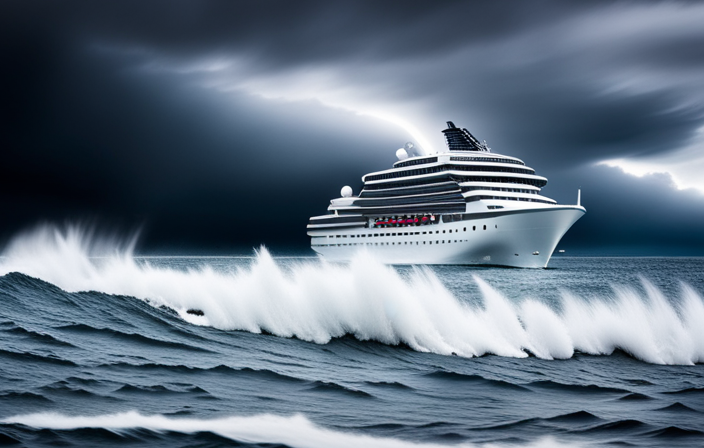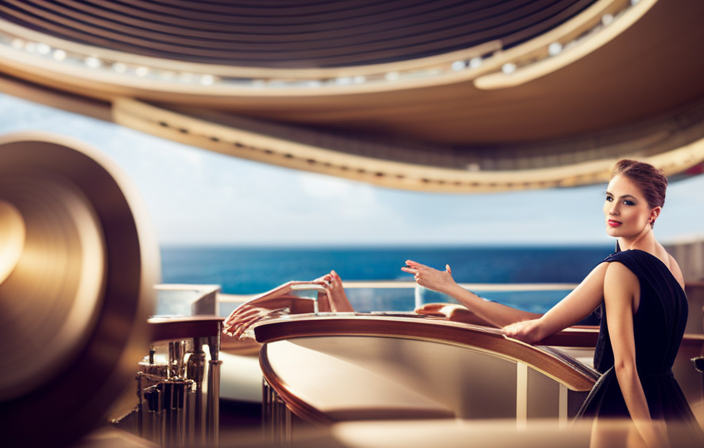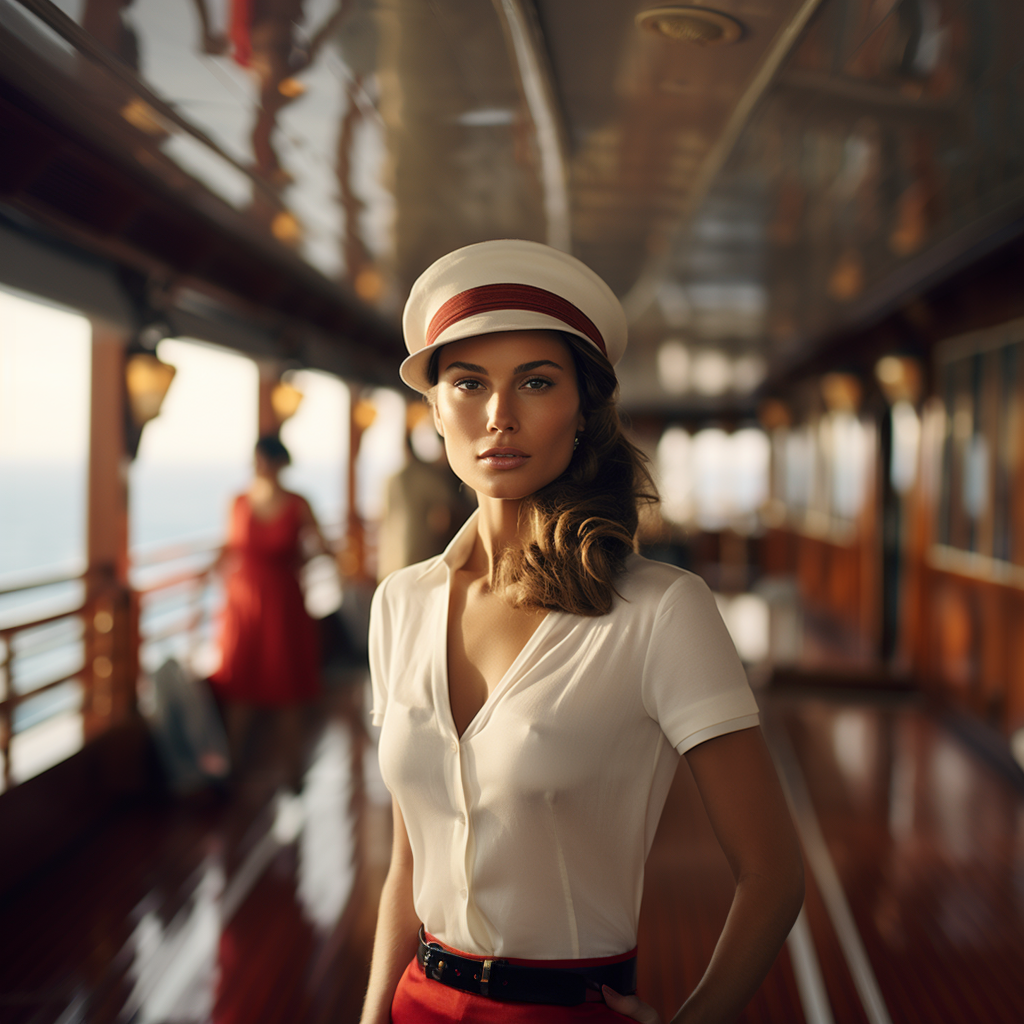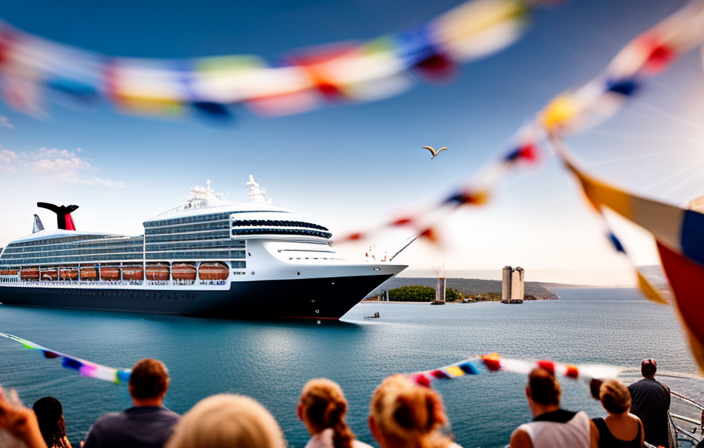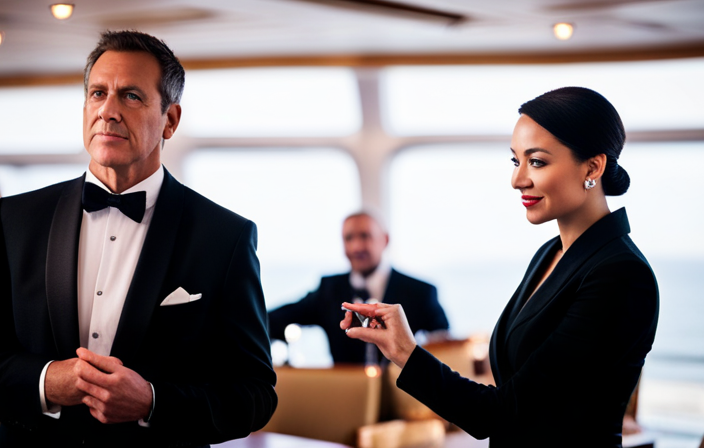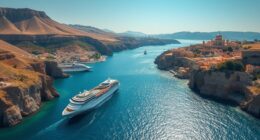Have you ever wondered how often cruise ships run into storms? Fascinated endlessly by the workings of the cruise industry, I delved into this topic to provide a thorough and insightful examination of the situation.
In this article, we will explore the various safety measures that cruise lines employ to ensure the well-being of their passengers during stormy weather. From the frequency of storm encounters to the technology and innovation used for storm avoidance, we will examine every aspect that contributes to the safety of those on board.
Additionally, we will explore the role of the captain in navigating through storms and the communication channels that cruise lines establish to keep passengers informed and secure.
So, sit back, relax, and join me on this informative journey as we uncover the truth about how often cruise ships find themselves caught in storms.
Key Takeaways
- Advanced weather monitoring systems and radar technology help cruise ships anticipate and avoid storms.
- Stabilizers and anti-roll systems, such as fin stabilizers and gyroscopic stabilizers, are used to counteract ship rolling and reduce motion during storms.
- Crew members undergo extensive emergency response training, including handling fires, medical emergencies, and natural disasters, to ensure preparedness in challenging conditions.
- Clear communication and guidance to passengers, along with regular safety drills and training for crew members, are crucial in promoting passenger safety and maintaining order during storms.
Understanding Cruise Ship Safety Measures
You’ll be surprised to learn about the extensive safety measures that cruise ships have in place to ensure your well-being on board.
Cruise ship evacuation procedures are meticulously planned and rehearsed to ensure that passengers can quickly and safely evacuate the ship in the event of an emergency. These procedures include designated muster stations, lifeboats, and life rafts strategically placed throughout the ship.
Additionally, all passengers are required to participate in safety drills at the beginning of the cruise, where they are instructed on emergency procedures and the location of life jackets.
Cruise ships also utilize advanced weather tracking systems to monitor and avoid storms whenever possible. Despite these precautions, it is important to note that storms can still occur unexpectedly at sea.
Transitioning into the next section, it is crucial to understand how often cruise ships encounter storms and how they handle these situations.
Frequency of Storm Encounters
Frequent encounters with storms can pose a significant challenge for cruise ships. These mammoth vessels are designed to withstand a wide variety of weather conditions, but storms can still disrupt their itineraries and cause inconvenience for passengers.
To mitigate the impact of storms, cruise ships rely on advanced storm tracking technology. This technology allows them to monitor weather patterns in real-time and make informed decisions about altering their course or delaying departure.
Despite these precautions, storms can still force cruise ships to change their planned routes or skip certain ports of call for safety reasons. This can be disappointing for passengers who were looking forward to specific destinations. However, the safety and well-being of passengers always take priority.
In the next section, we will explore how cruise lines communicate with passengers and ensure their safety during stormy conditions.
Cruise Line Communication and Passenger Safety
Navigating stormy seas can be a test of strength and resilience for cruise ships, but rest assured, these colossal vessels have robust communication systems in place to ensure your safety. Cruise lines prioritize passenger safety by implementing effective communication protocols during storm encounters. These systems enable the ship’s crew to receive real-time weather updates, allowing them to make informed decisions regarding route adjustments and potential storm avoidance. Additionally, cruise ships maintain constant contact with land-based weather monitoring centers, which provide vital information about storm patterns and intensities. Passengers are kept informed through various channels, including onboard announcements, digital displays, and in-room communication devices. This open line of communication allows passengers to stay informed about the current weather conditions and any necessary safety measures. With these comprehensive communication systems in place, cruise lines ensure that passenger safety remains a top priority. Moving on to the next section, the captain’s role in storm navigation is crucial in further guaranteeing a safe journey.
Captain’s Role in Storm Navigation
When the seas get rough, the captain becomes the guiding force, skillfully maneuvering the ship to ensure a safe and smooth journey for everyone on board.
The captain’s decision-making skills are crucial in storm navigation. They analyze weather reports, consult with meteorologists, and rely on their experience to determine the best course of action. The captain must consider factors such as wind speed, wave height, and the ship’s stability to make informed decisions.
Crew coordination is also vital during storms. The captain works closely with the crew, assigning specific duties and ensuring effective communication. Together, they monitor the ship’s systems, adjust navigation plans, and implement safety protocols. This collaborative effort helps to maintain stability and minimize risks.
Transitioning into the subsequent section, technology and innovation play a significant role in storm avoidance, providing additional tools for captains to navigate challenging weather conditions.
Technology and Innovation in Storm Avoidance
In today’s high-tech world, it’s mind-boggling how cruise ship captains still rely on their own experience and intuition instead of embracing the countless innovative storm avoidance technologies available.
With the advent of storm detection technology and advanced navigation systems, cruise ships have the means to navigate around storms efficiently and safely. Storm detection technology, such as weather radar and satellite imagery, provides real-time information about the location and intensity of storms, allowing captains to make informed decisions.
Additionally, advanced navigation systems, including GPS and autopilot, assist in precise route planning and course adjustments. These technologies not only enhance the safety of passengers and crew but also minimize disruptions to cruise itineraries.
As cruise ship captains continue to harness the power of technology, their collaboration with maritime authorities is further strengthened, ensuring a seamless and coordinated approach to storm avoidance strategies.
Without missing a beat, let’s delve into the next section about collaboration with maritime authorities.
Collaboration with Maritime Authorities
Working hand in hand with maritime authorities, captains embrace collaboration to ensure the utmost safety of passengers and crew during stormy seas. This collaboration involves adhering to strict maritime regulations that dictate the actions and decisions made by captains when faced with inclement weather. By following these regulations, captains can effectively navigate through storms while minimizing risks and maximizing safety.
Additionally, cruise ships rely on advanced weather forecasting systems specifically designed for cruise ship operations. These systems provide captains with real-time updates on weather conditions, allowing them to make informed decisions and adjust their routes accordingly. By combining their expertise with the technology at their disposal, captains can successfully steer their ships away from dangerous storms.
Transitioning into the subsequent section about passenger comfort during storms, it is important to note that prioritizing safety also involves ensuring a comfortable experience for passengers.
Passenger Comfort during Storms
When it comes to passenger comfort during storms, two key factors come to mind: stabilizers and anti-roll systems, and design features for smooth sailing.
Stabilizers and anti-roll systems are crucial in reducing the motion and swaying of the ship, ensuring a more comfortable experience for passengers.
Additionally, design features such as the hull shape and weight distribution play a significant role in minimizing the impact of rough seas, allowing for smoother sailing even in challenging weather conditions.
These features not only enhance passenger comfort but also contribute to the overall safety and stability of the cruise ship.
Stabilizers and Anti-roll Systems
Cruise ships equipped with stabilizers and anti-roll systems ensure a smoother sailing experience, providing passengers with peace of mind even in the face of stormy seas. These state-of-the-art systems are designed to maximize stabilizer effectiveness and minimize the impact of adverse weather conditions.
Here are some key features of these systems:
-
Active fin stabilizers: These fins are attached to the hull and can be extended or retracted to counteract the rolling motion of the ship.
-
Gyroscopic stabilizers: These devices use a spinning gyroscope to create a stabilizing force, reducing the ship’s rolling motion.
-
Anti-roll tanks: These tanks are filled with seawater and strategically placed to dampen the ship’s rolling motion.
-
Advanced weather monitoring systems: These systems allow the ship’s crew to anticipate and navigate around severe weather conditions.
-
Computer-controlled systems: These systems constantly adjust the stabilizers and anti-roll tanks to maintain stability.
By incorporating these advanced design features, cruise ships ensure a more comfortable voyage for their passengers.
Moving on to the next section about design features for smooth sailing…
Design Features for Smooth Sailing
Imagine yourself on a luxurious cruise, gliding effortlessly through the open sea, thanks to the innovative design features that guarantee a smooth and enjoyable sailing experience.
Weather forecasting techniques play a crucial role in ensuring that cruise ships avoid potential storms. Advanced radar systems and satellite technology allow cruise lines to closely monitor weather patterns and make necessary course adjustments to avoid dangerous conditions.
Additionally, proper ballast distribution is vital for maintaining stability on board. Cruise ships are equipped with sophisticated ballast systems that distribute weight evenly throughout the vessel, minimizing the risk of rolling or pitching in rough seas. By carefully managing ballast, cruise ships can navigate through turbulent waters with ease.
As we transition into the next section about crew training and certification, it is important to note that these design features alone cannot guarantee safety at sea.
Crew Training and Certification
In my experience as a crew member, one of the most important aspects of our training is emergency response. We are extensively trained on how to handle various emergency situations that may arise on board, such as fires, medical emergencies, and even natural disasters. This training ensures that we are well-prepared to respond quickly and effectively in challenging conditions, keeping both passengers and crew safe.
Additionally, seamanship skills are crucial for us to navigate through challenging conditions, such as storms or rough seas. We are trained to handle the ship in these conditions, ensuring that it remains stable and maneuverable.
Overall, our training and certification programs equip us with the necessary skills and knowledge to handle any situation that may arise at sea.
Emergency Response Training
You should be prepared for emergency situations at sea by receiving proper training. Emergency response protocols and crew coordination are essential for ensuring the safety of passengers and crew members on a cruise ship. In order to handle emergencies effectively, crew members undergo extensive training in emergency response procedures. This training includes drills and simulations to simulate real-life emergency situations, allowing crew members to practice their response and coordination skills.
One important aspect of emergency response training is the use of a 2-column, 3-row table to outline the steps and responsibilities of crew members during various emergency scenarios. This table helps to visually organize the information and ensure that everyone is clear on their roles and responsibilities. It also serves as a quick reference guide during high-stress situations.
By having a well-trained and coordinated crew, cruise ships can effectively respond to emergencies and ensure the safety of everyone on board. This training is crucial for maintaining the highest level of preparedness and minimizing the risks associated with emergency situations at sea.
Transitioning to the subsequent section about ‘seamanship skills in challenging conditions,’ it is important to note that emergency response training is just one aspect of a cruise ship crew’s overall skillset.
Seamanship Skills in Challenging Conditions
Navigating through rough seas requires sailors to possess exceptional seamanship skills. They must skillfully maneuver the ship amidst towering waves and fierce winds. It is during these challenging conditions that the true expertise of a sailor is tested.
Some of the seamanship challenges faced include:
- Maintaining stability: Balancing the ship in rough seas is crucial to prevent capsizing or rolling excessively.
- Steering control: The ability to steer the ship accurately is vital to navigate through rough seas and avoid colliding with other vessels or obstacles.
- Handling heavy weather: Sailors must be adept at handling the ship when faced with strong winds, ensuring it remains on course.
- Managing sea sickness: Being able to perform effectively despite feeling unwell is important for the safety and comfort of passengers and crew.
- Emergency response: Seamanship skills are vital for responding swiftly and effectively to emergencies that may arise during rough seas.
These challenges highlight the importance of seamanship skills in ensuring the safety and well-being of everyone on board.
As we explore the passenger responsibilities during storms, it becomes evident how their cooperation is integral to a successful voyage.
Passenger Responsibilities during Storms
During storms, it’s important for passengers to be aware of their responsibilities and to always follow the instructions of the crew. Effective passenger communication is crucial in these challenging conditions.
Cruise ships have well-established evacuation procedures in place, and it is essential for passengers to familiarize themselves with these protocols. They should pay attention to the safety drills conducted at the beginning of the voyage and be aware of the location of their life jackets and emergency exits.
Additionally, passengers should remain calm and avoid panicking during storms as this can hinder the crew’s efforts to maintain order and ensure everyone’s safety. By being cooperative and responsible, passengers can contribute to a safer and more efficient response to stormy weather.
Transitioning into the next section, cruise line accountability and safety records provide further insights into the measures taken to protect passengers during storms.
Cruise Line Accountability and Safety Records
When it comes to cruise line accountability and safety records, it’s important to understand how these factors play a role in ensuring the well-being of passengers amidst turbulent weather conditions. The cruise line liability in case of storms is a crucial aspect to consider. Passengers rely on the cruise line to prioritize their safety and take necessary precautions during inclement weather. Cruise lines must have well-established safety protocols and contingency plans in place to mitigate potential risks.
To ensure passenger compensation and safety, cruise lines should:
-
Implement advanced weather monitoring systems to track storms and make informed decisions regarding itinerary changes.
-
Conduct regular safety drills and training for crew members to handle emergencies effectively.
-
Provide clear communication and guidance to passengers during storms, including instructions on necessary precautions and procedures.
By adhering to these measures, cruise lines can demonstrate their commitment to passenger safety and minimize the risks associated with stormy weather conditions.
Frequently Asked Questions
What safety measures are in place to protect passengers and crew in the event of a storm on a cruise ship?
In the event of a storm on a cruise ship, extensive safety protocols and emergency procedures are in place to protect passengers and crew. These measures ensure everyone’s well-being and minimize risks during challenging weather conditions.
How often do cruise ships encounter storms during their voyages?
Cruise ships encounter storms during their voyages with varying frequencies. The impact of storms on cruise ship itineraries can range from minor delays to complete itinerary changes, depending on the severity and timing of the storm.
How do cruise lines communicate with passengers and ensure their safety during stormy weather?
Cruise lines prioritize passenger safety during stormy weather by utilizing various communication methods. They provide regular updates, use emergency systems, and instruct passengers on safety procedures. This ensures a smooth and secure sailing experience.
What is the role of the captain in navigating a cruise ship through a storm?
The captain’s decision making during a storm is crucial. Using navigation techniques like radar, weather forecasting, and communication with the crew, the captain ensures the safety of the ship, passengers, and crew.
What technological advancements and innovations have been implemented to help cruise ships avoid storms?
Technological advancements and storm avoidance innovations have greatly improved cruise ship navigation. Advanced weather monitoring systems, satellite communication, and real-time radar allow captains to detect and avoid storms, ensuring the safety and comfort of passengers.
Can Cruise Ships Avoid Storms and Hurricanes?
Cruise ships have sophisticated technology and expert meteorologists to monitor weather patterns. They can reroute or adjust schedules to avoid storms and hurricanes. Additionally, cruise ship hurricane activities include implementing safety protocols to ensure passenger and crew safety during rough weather conditions.
Conclusion
In conclusion, it is clear that cruise ships are well-prepared to handle storms and prioritize passenger safety.
While the frequency of storm encounters can vary, cruise lines have implemented various safety measures, such as advanced technology and captain expertise, to avoid dangerous weather conditions.
Crew training and passenger responsibilities also play a crucial role in ensuring everyone’s well-being during stormy situations.
Rest assured, cruise lines are held accountable and maintain safety records to provide a comfortable and secure experience.
So fear not, stormy seas are no match for these resilient floating paradises!
Meet Asra, a talented and adventurous writer who infuses her passion for exploration into every word she writes. Asra’s love for storytelling and her insatiable curiosity about the world make her an invaluable asset to the Voyager Info team.
From a young age, Asra was drawn to the power of words and their ability to transport readers to far-off lands and magical realms. Her fascination with travel and cultures from around the globe fueled her desire to become a travel writer, and she set out on a journey to turn her dreams into reality.

